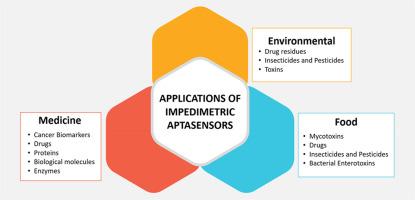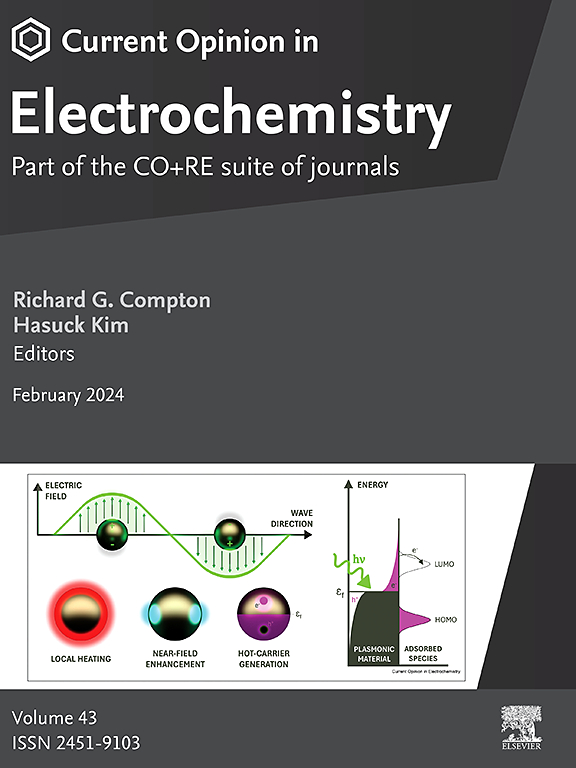Impedimetric aptasensors: Emerging tools for sensitive detection in health, food, and environmental monitoring
IF 6.9
2区 化学
Q1 CHEMISTRY, PHYSICAL
引用次数: 0
Abstract
Electrochemical impedance spectroscopy (EIS)-based aptasensors combine the high selectivity of aptamers as biorecognition elements with the label-free, sensitive, and noninvasive measurement capabilities of EIS. Owing to these features, they have recently attracted considerable attention, offering a wide range of applications from the early diagnosis of numerous biomarkers in the field of healthcare to food safety and environmental analysis. In this review, the fundamental principles of impedimetric aptasensors are discussed, and studies published over the last two years in the fields of health, food, and environment are comprehensively examined. In this context, recent original research on the development of aptasensors for the detection of various analytes including cancer biomarkers, viral and bacterial pathogens, mycotoxins, antibiotic residues, hormones, and heavy metals has been analyzed in detail. Moreover, recent findings supporting the applicability of these aptasensors in complex biological (e.g. serum, plasma, saliva, urine), food (e.g. milk, fruit juice, cereal products), and environmental (e.g. wastewater, river water) sample matrices have been summarized. Additionally, key application-oriented challenges such as optimization of surface chemistry for aptamer immobilization, minimization of matrix effects, sensor surface stability, repeatability/reproducibility, multiplex detection, and integration into portable platforms have been thoroughly discussed. Furthermore, innovative solutions that could facilitate the transition of this technology into clinical and field applications, as well as future perspectives regarding commercialization, have been presented. In this regard, it is emphasized that impedimetric aptasensors possess strong potential not only at the laboratory scale but also as powerful tools for real-world diagnostic and monitoring applications.

阻抗感应传感器:用于健康、食品和环境监测中敏感检测的新兴工具
基于电化学阻抗谱(EIS)的适体传感器将适体作为生物识别元件的高选择性与EIS的无标签、敏感和无创测量能力相结合。由于这些特点,它们最近引起了相当大的关注,提供了广泛的应用,从医疗保健领域的许多生物标志物的早期诊断到食品安全和环境分析。在这篇综述中,讨论了阻抗适体传感器的基本原理,并对近两年来在健康、食品和环境领域发表的研究进行了全面审查。在此背景下,对近年来用于检测各种分析物(包括癌症生物标志物、病毒和细菌病原体、真菌毒素、抗生素残留、激素和重金属)的适体传感器的原始研究进行了详细分析。此外,最近的研究结果支持这些适体传感器在复杂生物(如血清、血浆、唾液、尿液)、食品(如牛奶、果汁、谷物制品)和环境(如废水、河水)样品基质中的适用性。此外,关键的面向应用的挑战,如优化表面化学的适配体固定,最小化矩阵效应,传感器表面稳定性,可重复性/再现性,多重检测,并集成到便携式平台进行了深入的讨论。此外,还提出了创新的解决方案,可以促进该技术向临床和现场应用的过渡,以及未来商业化的前景。在这方面,强调阻抗感应传感器不仅在实验室规模上具有强大的潜力,而且在现实世界的诊断和监测应用中也具有强大的工具。
本文章由计算机程序翻译,如有差异,请以英文原文为准。
求助全文
约1分钟内获得全文
求助全文
来源期刊

Current Opinion in Electrochemistry
Chemistry-Analytical Chemistry
CiteScore
14.00
自引率
5.90%
发文量
272
审稿时长
73 days
期刊介绍:
The development of the Current Opinion journals stemmed from the acknowledgment of the growing challenge for specialists to stay abreast of the expanding volume of information within their field. In Current Opinion in Electrochemistry, they help the reader by providing in a systematic manner:
1.The views of experts on current advances in electrochemistry in a clear and readable form.
2.Evaluations of the most interesting papers, annotated by experts, from the great wealth of original publications.
In the realm of electrochemistry, the subject is divided into 12 themed sections, with each section undergoing an annual review cycle:
• Bioelectrochemistry • Electrocatalysis • Electrochemical Materials and Engineering • Energy Storage: Batteries and Supercapacitors • Energy Transformation • Environmental Electrochemistry • Fundamental & Theoretical Electrochemistry • Innovative Methods in Electrochemistry • Organic & Molecular Electrochemistry • Physical & Nano-Electrochemistry • Sensors & Bio-sensors •
 求助内容:
求助内容: 应助结果提醒方式:
应助结果提醒方式:


